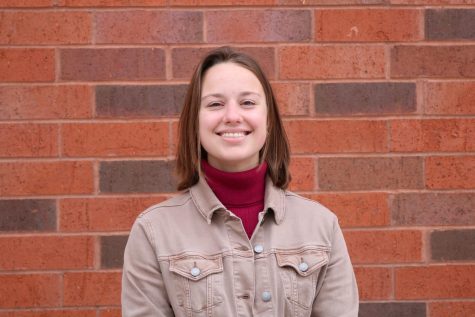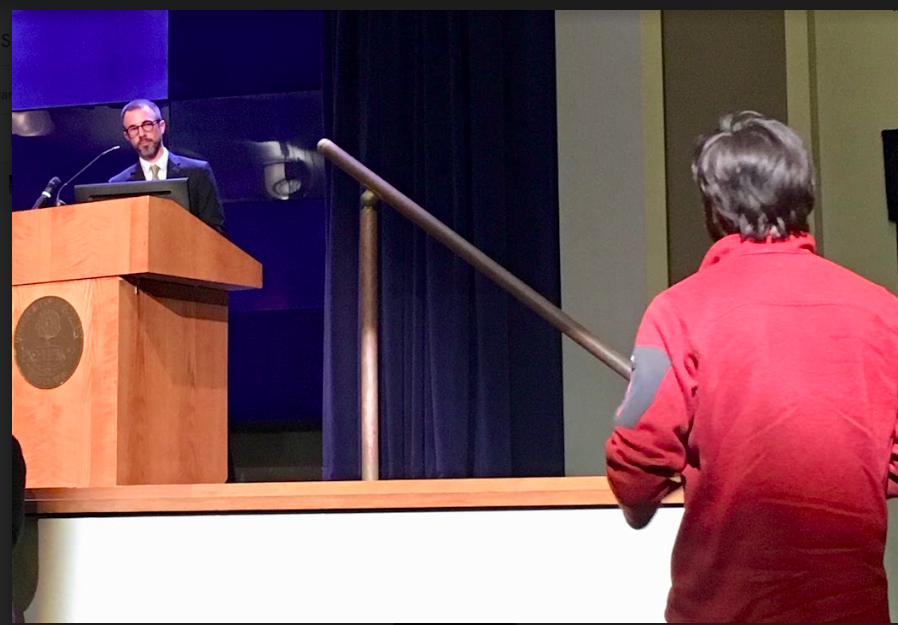The Forum: gerrymandering, its history and the Supreme Court
UW-Madison Professor presented implications of partisan redistricting on Wednesday night
Photo by Clara Neupert
An audience member asks Barry Burden a question after his presentation on gerrymandering. Burden helped co-found the Elections Research Center at UW-Madison.
This article also appears on blugoldmedia.org.
Gerrymandering and the court cases associated with the phenomenon have unexpected implications on the way elections in the United States function, said political scientist Barry Burden Wednesday at the University of Wisconsin-Eau Claire’s “The Forum” series.
“I prefer to think of (gerrymandering) as insulation,” Burden said. “Legislatures that are chosen by rigged districts are insulated from public influence; they are unaffected by the preferences of voters in a way that they would expect them to be.”
Gerrymandering is the redrawing of voting district lines with partisan interests in mind.
Burden is a professor at UW-Madison who has done extensive research in the field of election politics. His writing has been published and appeared in numerous peer-reviewed journals. Burden was a contributor to the 2018 gerrymandering case related to Wisconsin’s state legislative districts, Gill v. Whitford.
On Wednesday evening, Burden began with the basic facts and history behind gerrymandering before busting a few myths about its effects. Then, he spoke about the future of gerrymandering in the courts and in Wisconsin.
Historical roots of redistricting
Burden pronounced the word “gerrymandering” with a “G” instead of a “J,” as it is commonly pronounced, because of the word’s origin. In 1812, Massachusetts Governor Gerry Elbridge was coerced by his party in the legislature to sign into a law a set of voting district maps that would put his party in the advantage, Burden said.
A political cartoonist drew a map of one of the districts that curved its way around Boston, adding teeth, wings and feet to the shape it formed. The cartoonist likened the image to a salamander or a lizard and combined the words “Gerry” and “salamander” to create the term “gerrymandering.”
For a while the practice of gerrymandering was kept behind closed curtains, quietly placed in the hands of elected officials. Only recently, Burden said, has gerrymandering gained public interest by appearing in the news media, on social media and in popular culture.
Myths about gerrymandering
There are a few common misconceptions about gerrymandering, Burden said. And, in order to create solutions, the truth needs to be addressed.
“It’s easy to blame the ills of American politics — and there are a lot of them — on the redrawing of district lines,” Burden said. “I think there are a lot of things wrong with the process and I’m going to highlight those tonight. But I also want to make sure we separate things that are not the result of the redistricting process.”
Burden said redistricting itself is not evil. Sometimes it reflects a population change or protects the voice of a minority population.
One idea is that computers should take over the job of redrawing district lines. Although this method might sound fair, Burden said, a computer would disregard the complexity it takes to create a map.
Burden explained a mapmaker takes many components into account when creating district lines. They weigh in factors like the history of the district, the minority population of the district, how politically competitive the district is and many more. It would be next to impossible to create the perfect district, Burden said.
Finally, Burden said, gerrymandering is not the sole cause of partisan polarization. By analyzing the outcomes of elections by county, researchers found that cities are more Democratic now than ever before, and the suburbs around them are increasingly Republican. Home life, marriage and place of work provide just as much influence to polarization as do district lines.
The two principles influenced most by gerrymandering, Burden said, are responsiveness and symmetry.
When a party receives more votes in an election and therefore gains more seats in the legislature, that means the system is responsive.
A system is symmetric if success has equal outcomes for both parties.
“If earning 60 percent of the vote gets you a certain share of the seats and you’re a Democrat, then if it’s a good year for the Republicans and they manage to get 60 percent of the votes then they better get the same share of seats,” Burden said.
It was on the principles of responsiveness and symmetry that the Gill v. Whitford Supreme Court case was founded on, Burden said.
Gerrymandering and the courts: precedent and standing
A 1946 Supreme Court case, Colegrove v. Green, established the precedent that the courts shouldn’t be involved with issues of redistricting because it was a political issue. According to Oyez, Justice Felix Frankfurter wrote in his opinion that “Courts ought not to enter this political thicket.”
The precedent remained until the 2004 Vieth v. Jubelirer case. In a 5-4 decision, the Court yet again rejected the idea that the courts could have jurisdiction over redistricting. Burden said this allowed “horseplay” to occur as politicians from both sides of the isle found ways to create boundaries in their interests.
However, Justice Anthony Kennedy wrote a concurring opinion showing a deeper interest in the issue. Kennedy said he wanted more evidence that voters’ rights were being affected by gerrymandering. He also proposed there be a standard way to measure the impact of the location of a district line.
In 2017, retired UW-Madison law professor William Whitford and a group of other scientists and experts believed they’d gathered enough information to be able to convince Kennedy to consider gerrymandering under the law. So began the case called Gill v. Whitford.
Whitford argued that the district lines for the Wisconsin State Legislature heavily favored the Republicans. With the majority in the state’s leadership, the GOP redrew district lines so the party would maintain a majority despite any voting outcome. Whitford said this diluted Democratic votes statewide, therefore violating his rights as a voter.
Whitford’s argument was aided by a Senior Legal Council, Ruth Greenwood and Political Scientists, Nick Stephanopoulos and Eric McGee who created a standard for evaluating gerrymandering called the “efficiency gap.”
The Supreme Court decided unanimously in June 2018 that Whitford did not have standing for the case because he is a resident of Madison, a Democratic district, and therefore his vote is unharmed by gerrymandering. Kennedy, who had shown favorability to a reintroduction of a gerrymandering case with more evidence, kept quiet and resigned from the court after the case was closed.
After hearing about the efforts to challenging gerrymandering, Bob Jankowski, an Eau Claire resident, said he doesn’t think the Supreme Court is the best route — he said he thinks maybe a grassroots effort would be better suited.
“It just seems like an extreme uphill battle to change gerrymandering,” Jankowski said.
The case will reappear in the Supreme Court the summer of 2019. Burden said he thinks the best course of action to remedy gerrymandering in Wisconsin is to take the case to the state courts.
“It’s really a matter of fundamental fairness,” Burden said, “and about making legislative bodies more responsive to voters, and I don’t think there is anything more democratic than that.”
Neupert can be reached at neupercm7411@uwec.edu.

Neupert is a fourth-year journalism student at UW-Eau Claire. She is the executive producer of Engage Eau Claire on Blugold Radio Sunday. In her spare time, Neupert's working on becoming a crossword puzzle expert.


